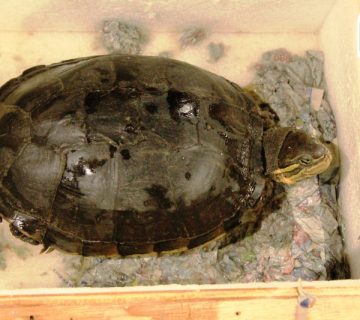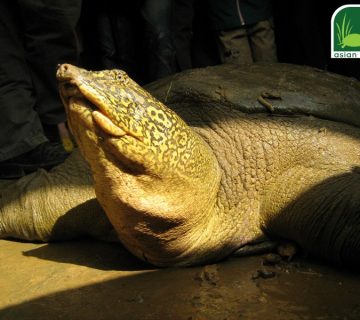At a site in Binh Son district, Quang Ngai province of central Vietnam the Asian Turtle Program (ATP) of Cleveland Metroparks Zoo has been working to preserve some of the best remaining wild habitat of the critically endangered and endemic Vietnamese Pond Turtle (Mauremys annamensis). The site comprises low rolling hills with three man made lakes fed by boggy wetland streams. Around the site a small number of Vietnamese Pond Turtles have been seen in the local trade since 2008 when the site was first identified, the closely related Chinese Stripe Necked Turtle (Mauremys sinensis) has more frequently been seen. With both M. annamensis and M. sinensis believed to occur sympatrically in wetland lowlands of central Vietnam many of the turtles seen in local communities have been caught in small ponds and rice field surrounding the site.
During non-lethal aquatic trapping in September 2011 at the largest lake in the complex five Mauremys sinensis were successfully trapped, with four animals in a single trap in one day. The site has been proposed as a new Species Habitat Conservation Area (SHCA) focused on turtle conservation with a Turtle Assurance Colony (TAC) for captive breeding located at the site.
Whilst on an unrelated visit to central Vietnam in May 2012 with two visiting European turtle biologists, Torsten Blanck and Sebastian Braun, the ATP received a call from a local counterpart at the Binh Son site. He reported that a 200m 2 pond had been drained for agriculture and 10 juvenile turtles had been caught. The team made a visit to the site to confirm the species where seven animals were seen, three others had reportedly died and been given to local people for food. Although the team were expecting to see Mauremys sinensis or Mauremys annamensis they were surprised to find all seven turtles were in fact hybrids between the two species, described as Mauremys glyphistoma . All the animals were juvenile ranging from 60 to 255 grams from which the team predict they were most likely last years off-spring.
Observation of these animals all reportedly wild caught was strong evidence that both Mauremys anamnesis and Mauremys sinensis occur in the area. This also brought the team to the possible hypothesis that there are limited adult individuals of each species in the wild for them to maintain separate breeding populations, leading to the wild hybridization.
The possibility of wild hybrids also raised the animal welfare and conservation conundrum as what to do with hybrids, especially if wild caught. Should they be released back into the wild, destroyed or be sold on into the wildlife trade? At present some households are keeping the turtles and have said they will transfer them to the ATP once the SHCA is established at the site.
Press release by: Pham Thi Thu Hien, Asian Turtle Program (ATP)
Date: 6th September 2012
Banner picture: One of seven Mauremys glyphistoma (hybrid between Mauremys sinensis and Mauremys annamensis) seen. Photo by Sebastian Braun
Thank you:


 We would like to thank the Critical Ecosystem Partnership Fund (CEPF), Disney Worldwide Conservation Fund and International Union for the Conservation of Nature (IUCN) – Netherlands Small grant for the Purchase of Nature (SPN) for supporting Mauremys annamensis conservation in Vietnam.
We would like to thank the Critical Ecosystem Partnership Fund (CEPF), Disney Worldwide Conservation Fund and International Union for the Conservation of Nature (IUCN) – Netherlands Small grant for the Purchase of Nature (SPN) for supporting Mauremys annamensis conservation in Vietnam.
Image Library:










No comment